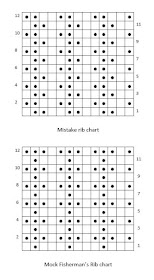For other possibilities, I've swatched a couple of stitch patterns from Barbara Walker's Treasury of Knitting Patterns. The first is Lace Rib. It meets my criterion - every other row is a repeat of p3, k2, so doesn't need much thought.
 |
| Lace Rib |
So that was a strong candidate. But being based on rib, it naturally concertinas inward - the swatch has been pressed to flatten it out, and even then it is perhaps not as drapy as I would like.
I have also knitted a swatch of Dewdrop Pattern. It's an 8 row pattern with 6 rows of k3, p3. The lacy increases and decreases all happen on the 4th and 8th rows. So it will be quite fast to knit, I think.
 |
| Dewdrop Pattern |
On the 4th and 8th rows of the pattern, you do a three-into-one decrease, which according to the instructions should be done as slip one, knit 2 together, pass slipped stitch over. But I found that the slipped stitch gets quite stretched when is passed over, and that stitch becomes a prominent part of the pattern, so that it isn't symmetrical. You might be able to see that in the bottom half of the swatch. (Again, Barbara Walker's doesn't seem to look like that.)
So I tried a different 3-into-1 decrease, where the centre stitch is on top. That's also easy to do. First, slip the first two stitches together, knitwise, That puts them on the right needle in reverse order. Then knit the 3rd stitch, and pass the first two stitches over it, either one at a time or both together. The result is that the 2nd stitch, i.e. the middle one of the three, ends up on top, with the other two tucked underneath it. I've done that in the top half of the swatch.
So I think dewdrop stitch will be my choice for the scarf. It's easy to knit, it lies flat, it drapes nicely, it's pretty. And another plus: although the pattern isn't reversible, and the wrong side looks completely different to the right side, it's quite presentable.
 |
| Dewdrop Pattern, reverse |











